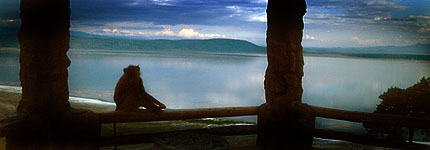Parks & reserves: Lake Nakuru National Park

 Managed by:
Managed by: KWS
Safari Card: Yes
|
 A baboon looks onto lake Nakuru from the Baboon Cliff lookout. J.Y./Kenyalogy.com
A baboon looks onto lake Nakuru from the Baboon Cliff lookout. J.Y./Kenyalogy.com
|
General info
Nakuru is arguably the most renowned among Kenya's Rift Valley lakes and one of the best known African parks in all the world, with its alkaline waters fringed at times by more than one million flamingos. American ornithologist Roger Tory Peterson, who pioneered modern environmentalism, defined it as "the greatest bird spectacle on earth", and the sentence has been used as a catchphrase ever since. Sadly, things are no longer like Peterson saw them, since human pressure is very much felt by the lake ecosystem and the huge flocks of birds are slowly but surely diminishing or fleeing to other more unspoilt soda lakes.
The park was gazetted in 1968, but since 1961 there was a bird sanctuary at the lake's south sector. With the support of the World Wildlife Fund, Kenya's Government launched a scheme to purchase the adjacent grounds in order to widen the protected area. In 1964 the sanctuary included the whole lake, with an area that fluctuates from 5 to 40 km², in addition to a shore strip. Since its gazetting as a national park, both authorities and conservation organisations have kept on winning the battle to private property and human settlings, further broadening the park limits in 1968 and 1974 to its current extension of 188 km².
But yet there is one threat the lake can't get rid of, and this is the populous and industrial Nakuru town, which lies only 4 km from the park. After Nairobi National Park, this is the second most accessible reserve in Kenya, since Nakuru is the fourth largest city in the country and the headtown of the Rift Valley. Therefore the park is one of the most visited both by Kenyans and foreigners, receiving huge numbers of visitors that peaked in 2007 with 346,800, according to the Ministry of Tourism. This is the reason why usually the park is heavily crowded and the sensation it delivers is more of a safari park than of the real wild Africa.
But people and traffic are not the only nor the biggest threats: uncontrolled dumping from the nearby city produces a strong environmental degradation, to such an extent that at critical times flamingos have completely vanished from the park. In 1994-95 there were massive flamingo deaths caused by water poisoning with heavy metals and toxins, due to a combination of climatic and human factors that favoured the overgrowth of cyanobacteria and toxic blue-green algae. This resulted in the start up of a program aimed at processing Nakuru's industrial and urban residues, water and pollution monitoring and protection of the lake basin.
In addition, encroachment by the surrounding population and poaching of rhinos urged the authorities to erect a 74 km wire fence around the park. The first fence was erected in 1976 and reinforced ten years later with a sun-powered electric fence, thanks to the cooperation of the British Rhino Rescue Trust.
The different measures are directed to protect an exceptionally important area for wildlife conservation, not only bird life diversity which inspired the park creation but also a great lot of mammal species, native or introduced, which live and breed successfully in the park. Among the latter are rhinos. The park was declared a sanctuary for the protection of these voluminous and endangered animals in 1987. From then on, reintroduction of specimens of both species, black and white, has made Nakuru one of the main rhino refuges in Kenya and the place where the visitor can easily find two of the five rhino species surviving in the world.
The park covers the lake and a land strip around the northern, eastern and western shores, whereas southward the grounds extend farther to Makalia Falls, which define the south limit. The shores are surrounded by swamps, that during the driest seasons disappear to give rise to huge white salt crusts. The riverine forest opens up southward in a bush and acacia tree savannah. The eastern and western shores are framed by ridges that offer splendid lookouts over the lake: Lion Hill, Baboon Cliff and Out of Africa. At the west shore, Baboon Cliff is the preferred home for some of the park's species, while at east, a part of Lion Hill is covered by a magnificent Euphorbia or candle tree forest, giving the landscape a prehistoric look. The park hosts several picnic areas and some hides have been erected near the lake for bird watching.
In addition to birds and rhinos, the park is home for a large number of mammals, including carnivores such as lions and leopards.
The short distance to the city and the frequent conflicts between environment conservation and development of the local communities have prompted a number of projects aiming at improving life conditions in the area and providing the residents a chance to meet this unique wildlife refuge. Kenya Wildlife Service has financed programs for health and education, namely for building classrooms and dispensaries, purchasing equipment and books, etc. On the other hand, the park owns a bus which offers low-priced guided tours to the park for Nakuru residents.
|



